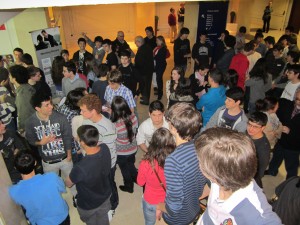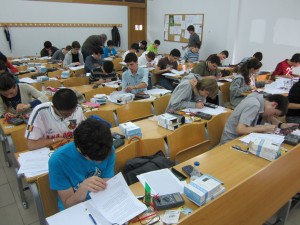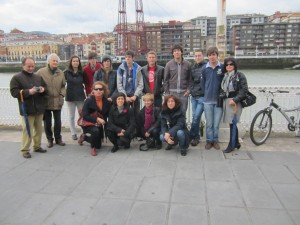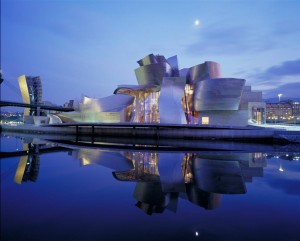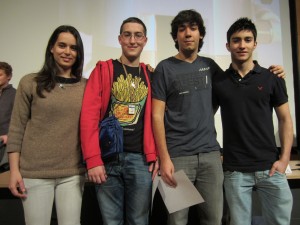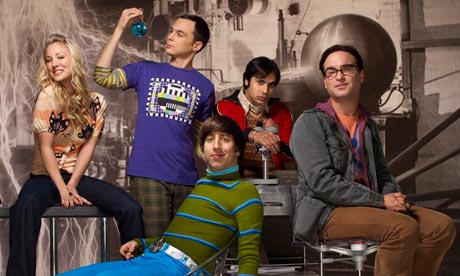
Chikugo river fireworks festival in Kurume, Fukuoka, Japan, 5 August 2011
Image courtesy of Kurume-Shimin; image source: Wikimedia Commons |
Did you realise that fireworks cause measurable air pollution? Tim Harrison and Dudley Shallcross from Bristol University, UK, explain how to investigate atmospheric pollutants in class.
Whether at New Year, on Guy Fawkes Night or at Diwali, most of us have witnessed a firework display – and remembered the explosions and showers of coloured light. What about the sulphurous smoke though? As atmospheric scientists have demonstrated, fireworks leave their mark on air quality for some time after the bangs and glows have passed. |
After the annual Guy Fawkes Night in the UK, highly elevated levels of particles (smoke or soot) produced by the fireworks’ combustion, as well as high levels of metal ions such as magnesium that originate from the fireworks themselves, have been found. Firework displays have also been linked to elevated levels of other molecules such as nitrogen dioxide (NO2) and sulphur dioxide (SO2). Such observations were made during and after a Diwali festival in Hisar City, India, in November 1999; in Mainz, Germany, during New Year celebrations in 2004/2005; during the Lantern Festival in Beijing, China, in 2006; and in Milan, Italy, the night after Italy won the football World Cup in 2006 (Drewnick et al., 2006;Ravindra et al. 2003; Vecchi et al., 2008; Wang et al., 2007).
Investigating air quality at school
Together with your students, you too can analyse the effect of fireworks on air quality. We worked with UK secondary-school students to investigate the impact of Guy Fawkes Night on air quality (see acknowledgements). The project was an introduction to using air-quality databases – which contain measurements of a wide range of pollutants, a treasure trove of data for use in schools – but also a chance to carry out some real research at school.
| Air quality can be linked to many school subjects. The chemistry and physics of fireworks involve a number of interesting topics, such as combustion, sound, light and the pollutants they can release. It can also form the basis of a deeper discussion of the nature of air pollution; what causes it, and effects such as acid rain and climate change. The latter are topics covered in biology, health and geography lessons. The analysis of data has huge potential for enlivening mathematics and IT lessons.
Information about the main pollutants caused by fireworks, as well as details of the chemistry of fireworks, can be downloaded from the Science in School websitew1. Further details on more general causes of air pollution can be downloaded from the UK-AIR websitew2. |

A beautiful sunset over Mumbai, India, caused by particulate matter in the air
Image courtesy of Bm1996; image source: Wikimedia Commons |
Databases

Fireworks at the Nagaoka festival, Japan
Image courtesy of Kropsoq; image source: Wikimedia Commons |
You will need to use a publicly available air-quality database that provides at least daily measurements for the location you are interested in studying. The UK air-quality archivew2 contains hourly data for a range of chemical species; primary pollutants (emitted directly), including NO, NO2, CO and SO2; hydrocarbons and particulate matter; and secondary pollutants (formed from primary pollutants), such as ozone. The data are collected from 186 sites around the UK ranging from monitors at the roadside to those in remote regions for measuring background levels. Some sites have been working since the mid-1970s, providing an incredible record of data. The authors are keen to work with any groups of students who wish to interpret aspects of the UK’s air-quality data. |
For Malta, there is the database of the Malta Environment and Planning Authorityw3 that contains data on CO, NO, NO2 and O3.
If you want to analyse data from another European country, you will find AirBasew4, the air-quality database maintained by the European Environment Agency, a useful resource as it contains measurements for most European countries. Note, however, that the files are large so can take some time to download, and are also less simple to understand than the UK and Maltese data sets.
Our results
| We analysed particulate matter (PM) levels at all sites where they are measured in the UK around Guy Fawkes Night 2009. PM consists of particles of solid or liquid suspended in a gas. They are categorised according to size as PM10 (diameter 10 µm or less), PM2.5 (2.5 µm or less), PM1 (1 µm or less) and ultrafine (0.1 µm or less). Firework combustion produces a range of particle sizes but mainly smaller particles (e.g. PM2.5) of soot, whereas bonfires can form larger particles. PM is also produced by the construction industry, and there are natural sources such as pollen, sea salt and wind-blown soil. Increased levels of particles in the air are linked to cardiovascular and respiratory diseases; smaller particles are particularly unhealthy because they can penetrate deeper into the respiratory system. PM also has a significant effect on the climate: soot particles warm the climate, whereas reflecting articles tend to cool it. |

New Year fireworks, 2010/2011, in Prague, Czech Republic
Image courtesy of Karelj; image source: Wikimedia Commons |
As an example (Figure 1), we show PM2.5 and PM10 levels from the centre of Reading, a university town in the south of the UK. Although Guy Fawkes Night is actually on 5 November, it is frequently celebrated on the nearest weekend. These data from 5-9 November 2009 show that particle levels peaked on the evening of 7 November (a Saturday). Comparing those data to the all-year average for 2009, we found that the levels on that Saturday were elevated by a factor of up to seven (see Figure 1).

Figure 1: PM10 and PM2.5 levels from Reading town centre, UK: levels on 7 November 2009, and the average levels for 2009.
Blue: PM2.5 on 7 November 2009; red: PM10 on 7 November 2009; green: PM2.5 average for 2009, purple: PM10 average for 2009.
Click on image to enlarge
Image courtesy of Tim Harrison and Dudley Shallcross
Because PM2.5 measures all particles with a diameter of 2.5 μm or less and the PM10 and PM2.5 levels are virtually the same, most particles produced were small – and particularly bad for the respiratory system. It is very difficult to set safe levels for particle exposure, but at present the limit for PM10 in Europe is an annual concentration of 40 μg/m3, and a daily concentration of 50 μg/m3, which must not be exceeded more than 35 times per calendar year (therefore called the exceedance). The average from the night of 7 November was 34.7 μg/m3, which is less than the exceedance, but much higher than the 2009 average (mean). At other sites in the UK, we found the PM10 level to be exceeded on that day.
Investigations
These databases offer a wealth of possible questions to be considered at school, with examples by no means restricted to firework-derived pollution. For example:
- Plot the levels of several different pollutants before, during and after a firework event (e.g. New Year). Which pollutants peak first? Which take longer to peak? Are the levels of all measured pollutants affected? Why / why not?
- Using data from different sites monitored in the database, compare levels of specific pollutants (e.g. carbon monoxide) between cities and countryside. What explanations can you find for what you observe?
|

A photomontage of eight images of fireworks from a Guy Fawkes Night display at Roundwood Park in Harlesden, London, UK
Image courtesy of Billy Hicks; image source: Wikimedia Commons |
- What differences are there in ozone levels from different locations and at different times of day?
- In Europe the prevailing wind is from the west. Can you detect any pattern in air quality from east to west?
Acknowledgements
The authors would like to acknowledge the help of the following teachers and students who participated in their UK air-quality study: Dr Oznur Kemal (teacher), Sophie Danby, Marta Tondera, Kelly Lam Ho, Candice Chan Ting Yan, Boni Chau Bo, Jenny Chow Kar Yee, Christine Fong Chi, Sophie Hawkins, Charlotte Hooper, Annabelle Fricker, Siobhan Stewart and Emma Tremewan, from Leweston School Dorset; Naomi Shallcross, Beth Shallcross and Esther Shallcross from Gordano School, Portishead; John Jones (teacher), Beth Jones and Cat Wood from Cheltenham College, Cheltenham.
References
Drewnick F et al. (2006) Measurement of fine particulate and gas-phase species during the New Year’s fireworks 2005 in Mainz, Germany. Atmospheric Environment 40: 4316-4327. doi: 10.1016/j.atmosenv.2006.03.040
Ravindra K, Mor S, Kaushik CP (2003) Short-term variation in air quality associated with firework events: a case study. Journal of Environmental Monitoring 5: 260-264. doi: 10.1039/B211943A
Vecchi R, et al. (2008) The impact of fireworks on airborne particles.Atmospheric Environment 42: 1121-1132. doi: 10.1016/j.atmosenv.2007.10.047
Wang Y, et al. (2007). The air pollution caused by the burning of fireworks during the lantern festival in Beijing. Atmospheric Environment 41: 417-431. doi:10.1016/j.atmosenv.2006.07.043
Web references
w1 – Supporting information on the chemistry of fireworks can be downloaded here in Word or PDF format.
w2 – The UK-AIR website hosts an extensive data archive, as well as plenty of information about air pollution. See: http://uk-air.defra.gov.uk
w3 – For air-quality data in Malta, see: www.mepa.org.mt/airquality
w4 – To download air-quality data from the European Environment Agency’s AirBase, see: www.eea.europa.eu/data-and-maps/data/airbase-the-european-air-quality-database-3
Resources
Russell MS (2000) The Chemistry of Fireworks. Cambridge, UK: The Royal Society of Chemistry. ISBN 0-85404-598-8
If you enjoyed this article, why not browse the full list of articles on chemistry topics published in Science in School? See: www.scienceinschool.org/chemistry
Dudley Shallcross (d.e.shallcross@bristol.ac.uk) is the professor of atmospheric chemistry at Bristol University, UK. Tim Harrison (t.g.harrison@bristol.ac.uk) is the outreach director for Bristol ChemLabS at Bristol University. They are frequent authors for Science in School.
Review
All that glitters is certainly not gold. The popular practice of letting off spectacular fireworks, following a football victory or as a full-blown festival spread over several nights, may in fact be contributing to air pollution. This article provides references and ideas for teachers to approach the topic of air pollution by using specific occasions when high levels of gaseous and particulate pollutants are expelled into the air during firework displays. Science students have the opportunity for real-life scientific investigations; rather than confining their experiments to the school laboratory, they are immersed in the scientific community, working to make our environment a better place to live in.
The article could be used in several science subjects: for example, in chemistry (properties and reactions of metallic compounds; burning; stability of compounds; oxidising agents), physics (propulsion; light and sound), or biology or health lessons (the effects of pollution on respiratory diseases, especially asthma). It could also be used interdisciplinarily to consider global warming.
If the school can borrow the necessary equipment – for example, from a university – the school students could even take their own measurements of air quality, which would expose them to the technical analysis of the air, data logging and handling, data comparison and error analysis. They could then perhaps present their findings to the local authority, experiencing for themselves how reliable results of scientific investigations can be used to put pressure on policy makers and potentially bring about improvements.
Angela Charles, Malta
 |
Referee’s recommendations: Chemistry, Physics, Biology, Health, Data-handling techniques, Global warming
Ages 14+ |


 trapping electrically charged atoms and measuring their properties with light particles. The results of their work have led to highly precise atomic clocks and provides a foundation that may one day make quantum computing a reality.. These two researchers took different approaches to solve this unique quantum problem, and their efforts have resulted in direct observation of single quantum particles without destroying them.
trapping electrically charged atoms and measuring their properties with light particles. The results of their work have led to highly precise atomic clocks and provides a foundation that may one day make quantum computing a reality.. These two researchers took different approaches to solve this unique quantum problem, and their efforts have resulted in direct observation of single quantum particles without destroying them.